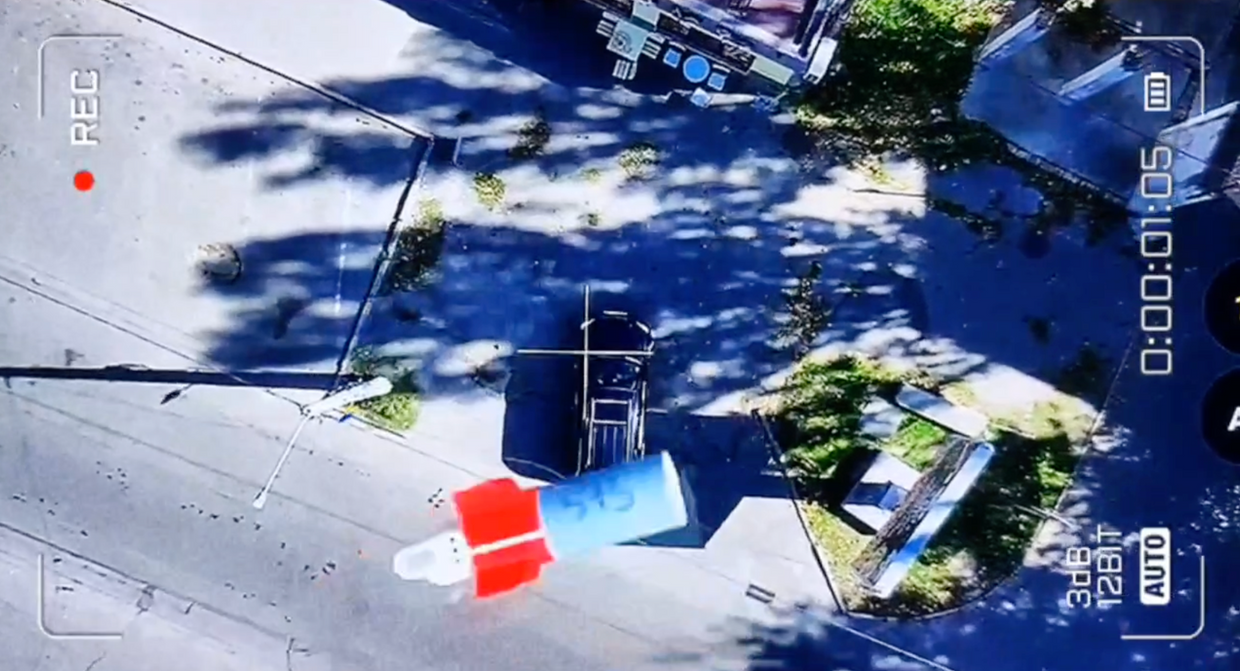
Humanitarian crisis in Kherson escalates but Russian river crossing remains unrealistic
Volunteers help local residents evacuate in Kherson, Ukraine, on Aug. 4, 2025. After Russian airstrikes damaged the bridge connecting Kherson with the Korabel neighborhood, evacuations were organized by volunteers and the local military administration. (Ivan Antypenko / Suspilne Ukraine / JSC “UA:PBC” / Global Images Ukraine via Getty Images)
After enduring a Russian occupation, a manmade flood, and drone attacks that turned its streets into a human safari, the southern Ukrainian city of Kherson could soon be made completely unlivable.
The extended range of Russian drones flown from across the Dnipro River has brought the main roads supplying Kherson — particularly the main highway connecting the city to Mykolaiv — under attack from the skies.
Meanwhile, on Aug. 2 and 3, Russian forces struck the road bridge to the Korabel neighborhood in the southwest of the city, seeking to destroy the only road connection between it and the mainland.
Kherson, with a pre-war population of 280,000, was the only new Ukrainian regional capital to be occupied in Russia’s full-scale invasion, falling to Russian forces in the first week of March. Ukrainian forces liberated it in November that year.

As of July, less than 65,000 people remain in Kherson, according to local authorities.
Those who have held out inside the city have done so amid an increasingly intense and far-reaching campaign of Russian strike drone attacks on civilian residents across the river, in a phenomenon that has been nicknamed a “human safari.”
These drones reach further with every passing month, while Russian airstrikes and assaults on the Dnipro Delta islands are also intensifying, putting the future of normal life in Kherson under grave doubt.
Neighborhood nearly cut off
Consisting of a mix of high-rise apartment buildings, one-story houses and holiday homes, and a large industrial area, the Korabel neighborhood in Kherson is located on a natural island in the far southwestern corner of the city on the bank of the Dnipro River.
Since the city's liberation from Russian occupation, the area has been one of the most dangerous and isolated parts of Kherson due to its proximity to Russian forces across the river.
The humanitarian situation in the neighborhood, also known as Ostriv (“Island”), deteriorated further when it was the worst-affected part of Kherson city proper in the aftermath of the flood caused by Russia's deliberate destruction of the Kakhovka Dam further upstream in June 2023.
Since then, as a result of repeated Russian strikes on critical infrastructure, as well as on repair teams, the area has been left without essential utilities, including gas, water, and electricity, on and off.

On Aug. 2, in a devastating blow for the remaining residents of the neighborhood, Russia struck the bridge with glide bombs, causing a large hole in the bridge's structure that blocked one lane of traffic.
The next day, more glide bombs targeted the bridge, with another hole created further down.
As of Aug. 5, the bridge is still traversable, but with great difficulty, and evacuations are continuing.
“If people stay there now and that bridge gets cut off, it will be impossible to evacuate them.”
According to regional authorities, of the approximately 1,700 residents who remained in Korabel at the time of the strike, over 400 have been evacuated so far, including 34 children and 41 people with limited mobility.


According to Fedorchuk, if the bridge is destroyed completely, the evacuation of the remaining residents will become nearly impossible.
“If people stay there now and that bridge gets cut off, it will be impossible to evacuate them,” she said.
With Kherson so far safe from a Russian ground attack thanks to the Dnipro River, Fedorchuk asserts that the destruction of the bridge is just yet another Russian move to terrorize the residents of Kherson into leaving their liberated home city.
“It’s clearly meant to cut people off from the city, and because it affects people’s state of mind, their morale, and it’s meant to discredit the authorities,” she said.
River front
Since all of Kherson Oblast on the western bank of the Dnipro River was liberated in 2022, the river itself has become a new front line of Russia's war against Ukraine.
Soon after, fighting began in the low-lying islands of the Dnipro River Delta, including those situated directly across from central Kherson.
The delta and the islands within it are a contested gray zone, where both Ukrainian and Russian forces operate, attempting to improve their positions.
In reality, the inability of soldiers on the islands to properly dig in due to the swampy ground means that troops from both sides are exposed on a permanent basis.
Nonetheless, Russian strikes on the Kherson front have escalated significantly in the past few months, spokesperson for the Ukrainian military’s southern command Vladyslav Voloshyn told the Kyiv Independent.


In addition to a higher rate of strikes by drones, artillery, and glide bombs, Russian forces have also increased attempts to conduct assaults on the islands themselves — so far unsuccessfully, losing two to three boats per day, Voloshyn said.
The increase in attacks across the river has led to speculation that Russia is preparing a larger ground offensive onto the western bank of the Dnipro, including into Kherson itself.
Voloshyn said that Russia is still far from having the capability to succeed in such an operation.
“It is very difficult to hide the troops, boats, and other equipment needed for that,” he said, “because our satellites and aerial reconnaissance will quickly spot such a concentration. At the moment, there is no evidence of such plans.”
“And if they gather 30 people, and they cross as a sabotage group, will they be able to capture Kherson? Unlikely.”
On edge
In the meantime, for residents of Kherson who have gotten used to living in Russian forces’ crosshairs for over 2.5 years, the threat to life is only increasing.
Compared to more dynamic parts of the front line, Kherson's situation is unique, with a large number of people living in a regional capital that — while not under immediate threat of assault and occupation — is in range of almost all weapons at Russia's disposal.
“Right now, in the riverside areas, drones are flying around like flies.”
In what has been widely reported on and documented as a “human safari,” Russian forces use both first-person view (FPV) drones and bomb-dropping drones to attack not only vehicles, humanitarian aid distribution points, and first responders, but also individual Ukrainian civilians themselves.
In a chilling display of violence, videos from these drone strikes — where it is usually clearly visible that the target is a civilian resident — are often posted by the Russians themselves on pro-war Telegram channels.
According to Voloshyn, Kherson ranks among the top parts of the front line in terms of the intensity of Russian drone activity, with around 250-270 FPV drones deployed against the city and the surrounding settlements on average per day, he told the Kyiv Independent.
For the civilian residents, especially in those areas closest to Russian positions, this means the constant threat of death from above.
“Right now, in the riverside areas, drones are flying around like flies,” said Fedorchuk.
“It’s constant stress — every time you go outside, you know something could happen.”
As Russia improves its drone warfare capabilities and increases the distance its drones can fly, bit by bit, more of Kherson has come into range.
In late June, the first reports came in of Russian drone attacks on cars on the main highway leading to Mykolaiv, leading to concerns that the city could be completely cut off.


For now, Voloshyn said, such attacks are an exception — a test of Russia's long-range drone capabilities in an area where the urban environment of Kherson presents a serious obstacle to long-range FPV drone flight.
“FPV drones are not yet able to reach it consistently, and for drones on fiber optic, it is necessary to fly all over the city,” he said. “At the moment, the enemy is now trying to work out how to achieve this.”
In the meantime, Ukrainian military units stationed in the area are constantly working to better protect both themselves and the residents of Kherson.
According to Voloshyn, this means creating a multi-layered network of countermeasures, from powerful electronic warfare devices to anti-drone netting hung up along the key roads in and around the city.
Meanwhile, the residents of Kherson are adapting in their own way, learning to live something akin to a normal life under a drone-infested sky.
“The first thing we have is a Telegram channel that constantly monitors these drone flights, logs them,” said Fedorchuk. “The channel reports where a drone is currently located, where there’s likely activity… Some people even carry drone detectors.”
But as enduring as the people are, says Fedorchuk, the mental burden of life in front-line Kherson is only accumulating, as the situation in the city continues to deteriorate.
“Even though we live in a fairly remote area, one of the safer parts of Kherson, when we had an encounter with a drone even in our district, I was shaken up for about a week. I kept hearing that buzzing sound in my head,” she said.
“Honestly, it’s really mentally crushing — truly.”
Note from the author:
Hi, this is Francis Farrell, the author of this piece. We’ve reported from over 30 front-line trips — often relying on cars rental from one lovely but slightly insane company that lets journalists drive them into a war zone. Having our own vehicle would make our field reporting quicker, safer, and truly independent. We’re currently fundraising to make that possible. Want to support or learn more? Contact our head of fundraising, Danica Stanciu, at d.stanciu@kyivindependent.com U.S. citizens can make tax-deductible donations through our 501(c)(3) partner.










